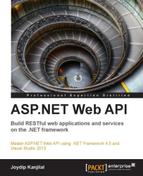Book Description
An opportunity for ASP.NET web developers to advance their knowledge with a practical course, designed from the ground up, to help you investigate REST-based services with C# 5. An essential, real-world tutorial.
- Clear and concise guide to the ASP.NET Web API with plentiful code examples
- Learn about the advanced concepts of the WCF-windows communication foundation
- Explore ways to consume Web API services using ASP.NET, ASP.NET MVC, WPF, and Silverlight clients
In Detail
The ASP.NET Web API was designed from the ground up to meet the need of developers who want to build HTTP/RESTful services. ASP.NET Web API is an HTTP service that uses HTTP as the application protocol and can return data based on the data format requested by the client. It is a lightweight web-based architecture that provides an easy-to-use set of default options while providing a deep extensibility infrastructure to meet the demands of any scenario using HTTP.
This book is a step-by-step, practical tutorial with a simple approach to help you build RESTful web applications and Web API services based on the .NET framework quickly and efficiently. This book provides complete coverage of RESTful services and the ASP.NET Web API in a lucid language with plenty of hands-on code examples.
The book starts with a description of REST-based architecture and WCF. It then explores the new features in ASP.NET 4.5 and introduces you to the new concepts in the ASP.NET Web API. There are also plentiful code examples throughout these sections to help you learn effectively.
You will then learn how to work with WCF REST-based services and the ASP.NET Web API and how to consume those services using various clients such as ASP.NET, ASP.NET MVC, WPF, and Silverlight.
In the second half of this book, we discuss the more advanced concepts of the ASP.NET Web API, best practices, and asynchronous programming concepts and how it can be implemented in C# 5.The most important thing you will take home from reading this book is a working knowledge on RESTful services, their architecture, how to build them, and also how to consume them with plenty of tips and techniques to better utilize this technology.
Table of Contents
- ASP.NET Web API
- Table of Contents
- ASP.NET Web API
- Credits
- About the Author
- About the Reviewers
- www.PacktPub.com
- Preface
- 1. Understanding Representational State Transfer Services
- Understanding REST
- Implementing RESTful services in .NET 4.5
- Summary
- 2. Understanding Resource and Service Oriented Architectures
- 3. Working with RESTful Services
- Exploring Windows Communication Foundation (WCF)
- Applying service behavior
- New features in WCF 4.5
- Making the service RESTful
- Summary
- 4. Consuming RESTful Services
- 5. Working with ASP.NET 4.5
- 6. Working with RESTful Data Using Silverlight
- 7. Advanced Features
- A. Library References
- Index
